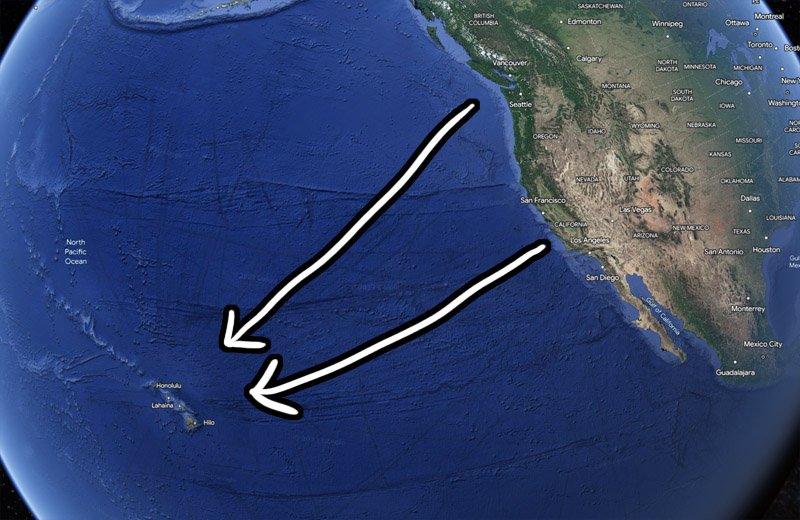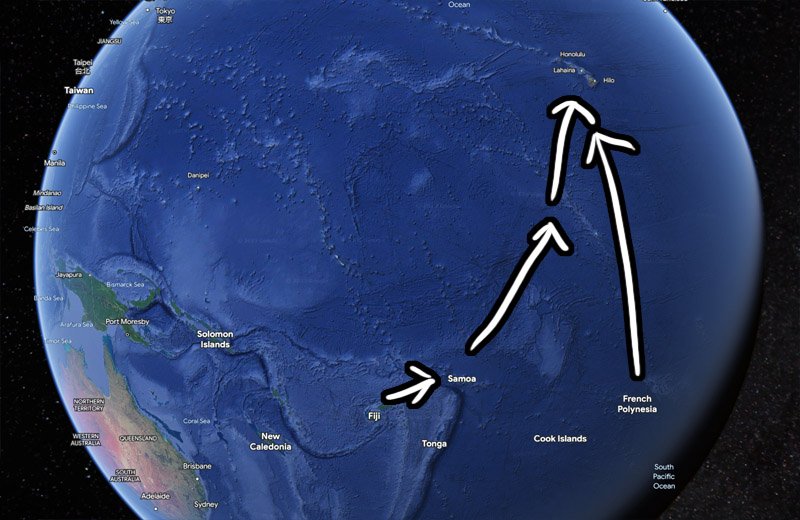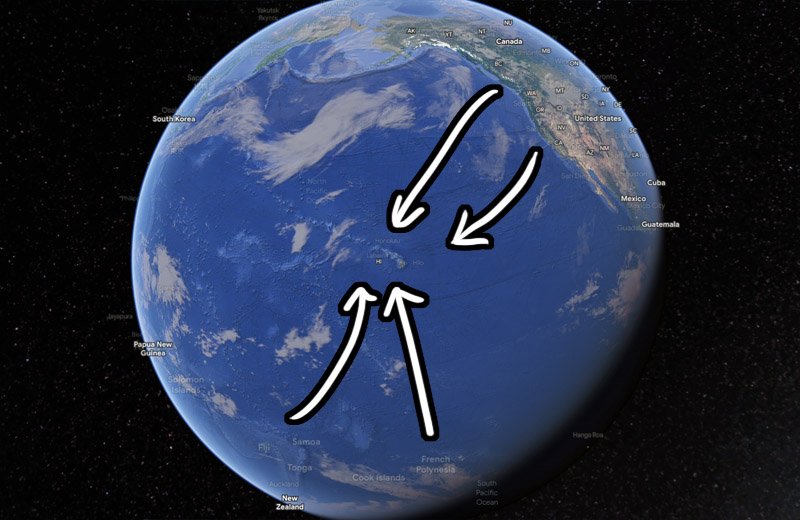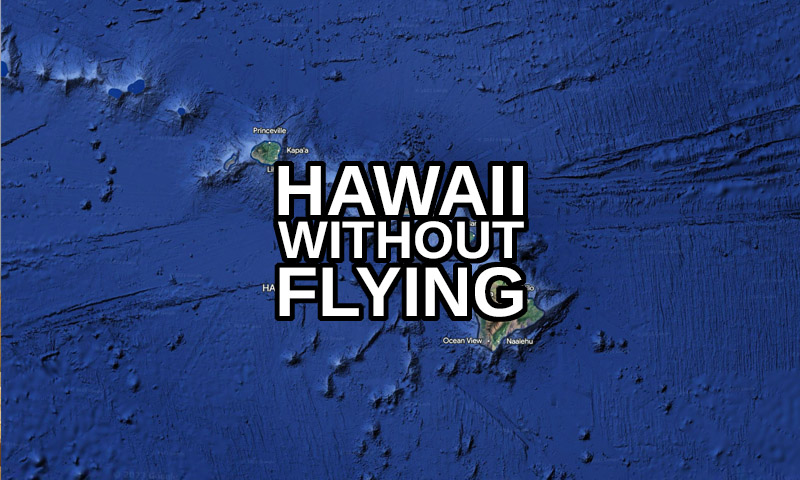How to get to Hawaii without flying? Although the options are limited, it is indeed possible to travel to Hawaii without taking a flight. Here’s a guide on how you can do it.
Hawaii, located in the middle of the Pacific Ocean, is one of the most remote archipelagos in the world. The closest continental shore is approximately 2,300 miles (3,700 kilometers) away on the US West Coast, while the coast of Japan lies about 3,700 miles (6,000 kilometers) in the opposite direction.
Given these vast distances, it’s no surprise that traveling to Hawaii without flying is extremely challenging. Still, it’s not entirely impossible.
I know many of you might still choose to fly to Hawaii because it’s easier. If you do decide to fly, please consider donating 10% of your ticket cost to a climate organisation suggested by Giving Green. Carbon offsetting isn’t very effective, so it’s better to support effective charities instead.
This guide will explore different ways to get to Hawaii without flying, starting with travel options from America and then examining routes from other directions.

How to Get from America to Hawaii without Flying
Let’s start with the unfortunate news. There are no ferries or regular passenger ships to Hawaii. However, it is possible to reach Hawaii on a cruise, although most cruises require you to depart from Hawaii on the same ship.
As of summer 2023, I found two cruises that offer one-way trips from America to Hawaii. These cruises depart from Vancouver in Canada and arrive in Honolulu, Hawaii, taking 7-9 days. Prices for these journeys start around $600.
If you have environmental concerns and want to avoid flying, it’s worth noting that cruises may produce more CO2 emissions compared to commercial flights.
Although less common, sailing from America to Hawaii is also a possibility. According to one source, sailing from California to Hawaii typically takes around two weeks. If you don’t have your own sailing boat, you can try finding opportunities to work for your passage through websites like Findacrew.net and CrewSeekers.net.
Finding voyages to Hawaii on Findacrew.net can be a bit challenging as the search results are only narrowed down to a country level. At the time of writing, the site listed 130 sailors looking for crew members heading to locations in the United States, with only two captains sailing to Hawaii.
However, the situation might be slightly more optimistic. When sailing across the Pacific from America to Australia or Oceania, it’s common to make a stop in Hawaii along the way. You can find more information about longer transpacific voyages here.

How to Reach Hawaii from Other Directions
Apart from America, you can consider traveling to Hawaii by ship or boat from Asia and Oceania. However, there are no regular ferries or passenger ships available.
I found one cruise ship, Norwegian Spirit, that offers one-way cruises from French Polynesia to Hawaii. These cruises take 12 nights, with prices starting from $900. Additionally, I came across one cruise from Japan to Hawaii, but it involves multiple stops, lasts over two months, and costs a minimum of $20,000.
Sailing from Asia or Oceania to Hawaii is possible, although it’s uncommon due to long distances and prevailing trade winds that work against you. Sailing in the opposite direction is more common, but there are a few reports online about sailing from Asia and the Pacific to Hawaii.
Fortunately, there are numerous islands in the southwest Pacific, so breaking the journey into smaller parts is feasible. Here’s one online thread about sailing from Fiji to Hawaii, and here are two sailing blogs about such journeys:
- Updates from Cambedoo (Fiji – Samoa – American Samoa – Cook Islands – Kiribati – Hawaii – Canada)
- Pandion (Fiji – Samoa – American Samoa – Kiribati – Hawaii – San Francisco)
At the time of writing, I couldn’t find any captains looking for crew members to sail to Hawaii from places other than America on Findacrew.net.

Can You Take a Cargo Ship to Hawaii?
So far, we’ve focused on two types of flightless travel to Hawaii: cruises and sailboats. However, what about freighter travel?
Freighter travel is a personal favorite of mine. I have crossed the Pacific on a cargo ship from New Zealand to California. Although it’s not cheap (prices start from $100 per day), I believe freighter travel is a great way to journey long distances quite sustainably.
Unfortunately, it seems that traveling to Hawaii on a cargo ship is not possible. According to one source, the freighter travel to Hawaii is handled by a cargo company that doesn’t accommodate passengers.
If you’re interested in learning more about freighter travel in other locations, you can refer to my guide “How to Prepare for Cargo Ship Travel? (Booking a Passage)”.

How to Get to Hawaii without Flying – A Summary
In summary, traveling to Hawaii without flying presents several challenges due to its remote location in the Pacific Ocean. Although the options are limited, it is still possible to reach the islands without taking a flight.
For travelers coming from America, the most feasible option is embarking on a cruise to Honolulu, Hawaii. Just note that cruises may have higher CO2 emissions compared to commercial flights.
Sailing from the US West Coast to Hawaii is another option, typically taking around two weeks. Freighter travel, a sustainable alternative for long-distance journeys, is not available for reaching Hawaii.
Traveling to Hawaii from other directions, such as Asia and Oceania, is even more challenging. Sailing from these regions to Hawaii is uncommon due to long distances and prevailing trade winds.
Ultimately, reaching the enchanting islands of Hawaii without taking to the skies requires careful planning and a spirit of adventure.




